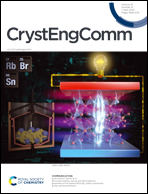A zinc-based metal–organic framework with a triazine moiety: effective detection of antibiotics and photodegradation dyes in aqueous solution†
Abstract
A zinc-based metal–organic framework was constructed by a solvothermal synthesis approach with the formula {[Zn3(ttta)2(H2O)4]}n (1–Zn) (where H3ttta = 4,4′,4′′-(1,3,5-triazine-2,4,6-triazinediyl) triazinic acid) and was successfully characterized. In terms of photocatalytic degradation, complex 1–Zn has a smaller energy band gap and higher degradation efficiency compared to many other Zn-MOFs, and it has good stability and recyclability. Fluorescence detection experiments showed that complex 1–Zn showed significant specificity in recognition of quinolone antibiotics compared to other antibiotics and showed a better fluorescence quenching rate of metronidazole (MDZ) and tetracycline hydrochloride (TCH). The photodegradation mechanism was investigated by ultraviolet-visible diffuse reflectance spectroscopy (UV-vis DRS) and valence band X-ray photoelectron spectroscopy (VB-XPS). A reasonable mechanism of the fluorescent probe and photodegradation of 1–Zn was determined by density functional theory calculations.



 Please wait while we load your content...
Please wait while we load your content...